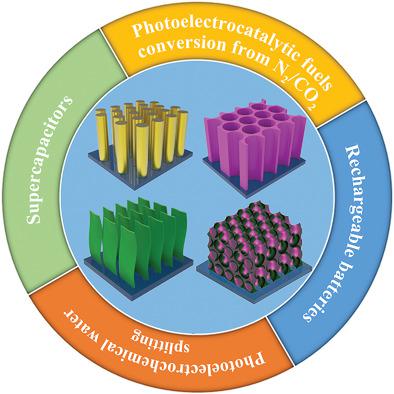当前位置:
X-MOL 学术
›
Adv. Energy Mater.
›
论文详情
Our official English website, www.x-mol.net, welcomes your feedback! (Note: you will need to create a separate account there.)
3D Nanostructures for the Next Generation of High‐Performance Nanodevices for Electrochemical Energy Conversion and Storage
Advanced Energy Materials ( IF 27.8 ) Pub Date : 2020-06-15 , DOI: 10.1002/aenm.202001460 Huaping Zhao 1 , Yong Lei 1
Advanced Energy Materials ( IF 27.8 ) Pub Date : 2020-06-15 , DOI: 10.1002/aenm.202001460 Huaping Zhao 1 , Yong Lei 1
Affiliation

|
Among the different nanostructures that have been demonstrated as promising materials for various applications, 3D nanostructures have attracted significant attention as building blocks for constructing high‐performance nanodevices. Particularly over the last decade, considerable research efforts have been devoted to designing, fabricating, and evaluating 3D nanostructures as electrodes for electrochemical energy conversion and storage devices. Although remarkable progress has been achieved, the performance of electrochemical energy devices based on 3D nanostructures in terms of energy conversion efficiency, energy storage capability, and device reliability still needs to be significantly improved to meet the requirements for practical applications. Rather than simply outlining and comparing different 3D nanostructures, this article systematically summarizes the general advantages as well as the existing and future challenges of 3D nanostructures for electrochemical energy conversion and storage, focusing on photoelectrochemical water splitting, photoelectrocatalytic solar‐to‐fuels conversion from nitrogen and carbon dioxide, rechargeable metal‐ion batteries, and supercapacitors. A comprehensive understanding of these advantages and challenges shall provide valuable guidelines and enlightenments to facilitate the further development of 3D nanostructured materials, and contribute to the achieving more efficient energy conversion and storage technologies toward a sustainable energy future.
中文翻译:

下一代高性能纳米器件的3D纳米结构,用于电化学能量转换和存储
在已被证明是可用于各种应用的有希望的材料的不同纳米结构中,3D纳米结构作为构建高性能纳米设备的基础材料而引起了极大的关注。特别是在过去的十年中,已经投入了大量的研究工作来设计,制造和评估3D纳米结构,作为电化学能量转换和存储设备的电极。尽管已经取得了显着进步,但是基于3D纳米结构的电化学能源设备在能量转换效率,能量存储能力和设备可靠性方面的性能仍需要显着提高,以满足实际应用的要求。与其简单地概述和比较不同的3D纳米结构,不如说是 本文系统地总结了3D纳米结构在电化学能量转换和存储方面的一般优势以及当前和未来的挑战,重点是光电化学水分解,氮和二氧化碳的光催化太阳能转化为燃料,可充电金属离子电池,和超级电容器。对这些优势和挑战的全面理解将提供宝贵的指导方针和启示,以促进3D纳米结构材料的进一步开发,并有助于实现更有效的能量转换和存储技术,以实现可持续的能源未来。专注于光电化学水分解,从氮和二氧化碳的光催化太阳能到燃料的转化,可充电金属离子电池和超级电容器。对这些优势和挑战的全面理解将提供宝贵的指导方针和启示,以促进3D纳米结构材料的进一步开发,并有助于实现更有效的能量转换和存储技术,以实现可持续的能源未来。专注于光电化学水分解,从氮和二氧化碳的光催化太阳能到燃料的转化,可充电金属离子电池和超级电容器。对这些优点和挑战的全面理解将提供宝贵的指导方针和启示,以促进3D纳米结构材料的进一步开发,并有助于实现更有效的能量转换和存储技术,朝着可持续的能源未来发展。
更新日期:2020-07-28
中文翻译:

下一代高性能纳米器件的3D纳米结构,用于电化学能量转换和存储
在已被证明是可用于各种应用的有希望的材料的不同纳米结构中,3D纳米结构作为构建高性能纳米设备的基础材料而引起了极大的关注。特别是在过去的十年中,已经投入了大量的研究工作来设计,制造和评估3D纳米结构,作为电化学能量转换和存储设备的电极。尽管已经取得了显着进步,但是基于3D纳米结构的电化学能源设备在能量转换效率,能量存储能力和设备可靠性方面的性能仍需要显着提高,以满足实际应用的要求。与其简单地概述和比较不同的3D纳米结构,不如说是 本文系统地总结了3D纳米结构在电化学能量转换和存储方面的一般优势以及当前和未来的挑战,重点是光电化学水分解,氮和二氧化碳的光催化太阳能转化为燃料,可充电金属离子电池,和超级电容器。对这些优势和挑战的全面理解将提供宝贵的指导方针和启示,以促进3D纳米结构材料的进一步开发,并有助于实现更有效的能量转换和存储技术,以实现可持续的能源未来。专注于光电化学水分解,从氮和二氧化碳的光催化太阳能到燃料的转化,可充电金属离子电池和超级电容器。对这些优势和挑战的全面理解将提供宝贵的指导方针和启示,以促进3D纳米结构材料的进一步开发,并有助于实现更有效的能量转换和存储技术,以实现可持续的能源未来。专注于光电化学水分解,从氮和二氧化碳的光催化太阳能到燃料的转化,可充电金属离子电池和超级电容器。对这些优点和挑战的全面理解将提供宝贵的指导方针和启示,以促进3D纳米结构材料的进一步开发,并有助于实现更有效的能量转换和存储技术,朝着可持续的能源未来发展。



























 京公网安备 11010802027423号
京公网安备 11010802027423号